If you’re anything like me, you’ve probably faced that sinking feeling when your phone hits 2% battery and your power bank is also dead. It’s the modern version of being stranded in the desert without water, except your desert is a busy workday or a long flight.
That’s when I realized choosing the right power bank charger isn’t just about buying one that charges stuff. It’s about finding a charger that matches your lifestyle, devices, and expectations.
In this post, I’ll share how I choose my power bank chargers, the mistakes I’ve made (and learned from), and what you should look for when buying yours without getting buried in tech jargon.
Here’s what you’ll learn:
- How to match your charger’s input and output to your devices
- What do those charging standards, like PD and QC, really mean
- Why fast charging doesn’t always mean faster
- The importance of safety certifications
- How many ports do you actually need?
- What makes travel chargers different
- Whether GaN chargers are worth the hype,
a few honest thoughts from someone who’s blown a few adapters in hotel rooms.
Understand What Your Power Bank Really Needs
Before I buy any charger, I ask myself one simple question: What am I actually charging most of the time?
If it’s just my phone, I don’t need a bulky, 100W charger. But if I’m traveling with a laptop, smartwatch, and earbuds, that’s a different story.
When I first started comparing power banks, I didn’t pay attention to “input ratings.” Big mistake. The input rating tells you how fast your charger can refill the power bank itself.
A 5V/2A input means slow charging; a 9V/2A or 12V/1.5A means it’ll recharge much faster. So even if your power bank has a big capacity, it’s useless if it takes 12 hours to recharge.
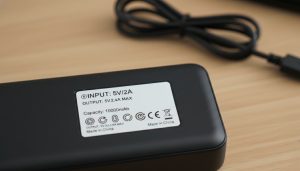
Check the Power Bank Input Rating Before You Buy
I’ve learned to check both input and output. Input affects how quickly the power bank recharges, and output determines how fast it charges your phone or laptop.
For example:
- Smartphones: 18W or 20W output is usually enough.
- Tablets: Look for 30W or more.
- Laptops: 45W to 100W output (depending on your device).
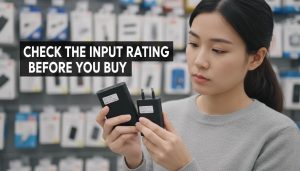
When I bought my first Anker charger, I assumed all USB-C ports were equal. Nope. Some only supported 15W. That’s enough for a phone but not for a MacBook. Lesson learned: check the specs, not just the brand.
Want more detailed comparisons? Check my https://pickerzen.com/best-power-bank/where I rank models by performance, price, and travel suitability.
Why Fast Charging Isn’t Always the Fastest Option
We all love speed. But “fast charging” isn’t as simple as it sounds.
Different devices use different technologies — and they don’t always play nicely together.
If you’ve ever plugged your phone into a friend’s charger and noticed it charged slowly, that’s because the protocols didn’t match.
Power Bank Charging Standards: PD vs. QC vs. PPS
Let’s break it down without the alphabet soup headache:
- PD (Power Delivery): Works great with iPhones, iPads, and laptops. Can deliver up to 100W. Uses USB-C.
- QC (Quick Charge): Common in Android devices. It adjusts voltage dynamically for safe, fast charging.
- PPS (Programmable Power Supply): The “smart” version that talks to your device to find the best voltage. Often used in Samsung phones.
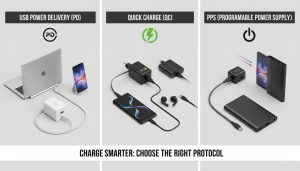
So when I buy a new charger, I check which protocol my device supports. My rule? If you’re using multiple brands (like an iPhone and a Samsung tablet), pick a charger that supports both PD and QC.
My Checklist for a Safe Charger
I once bought a no-name charger because it was half the price. It got dangerously hot after 20 minutes and nearly melted a cable. Never again.
Here’s my personal safety checklist now:
- CE, FCC, and RoHS certifications — must-have.
- Temperature control and surge protection.
- Overcharge and short-circuit prevention.
- Smart power distribution for multi-port chargers.
A good power bank charger doesn’t just charge your devices; it protects them.
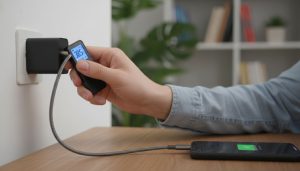
How Port Count Affects Real-World Charging
When it comes to ports, I used to think “the more, the better.” Not always true.
A 3-port charger sounds great until you realize total wattage gets divided between all ports. For example, a 65W charger might only deliver 45W when two devices are connected.
So here’s my rule of thumb:
- Single-port charger: Best for everyday carry.
- Two-port charger: Great for travel (phone + laptop).
- Three or more: Perfect for a family setup or desk use.
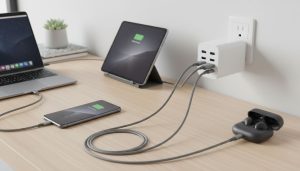
Single vs Multi-Port Chargers
If you constantly charge multiple devices, a GaN charger (Gallium Nitride) is your best friend. It’s smaller, faster, and runs cooler than traditional silicon ones.
But if you’re just carrying one phone, a compact single-port charger is more practical. My everyday pick? A 30W USB-C GaN charger small enough to fit in my pocket, strong enough for my iPhone and iPad.
Picking the Perfect Power Bank for Travel
Travel chargers are a different story. You want universal voltage (100–240V) support, foldable pins, and ideally, multi-port output.
I travel frequently for work, and I can’t count how many times I’ve forgotten the right adapter. Now, I only pack chargers that support Type A/C plugs and include replaceable heads.
A compact foldable GaN charger is placed next to the passport and travel adapter.
Power Bank Features That Make Travel Charging Easier
- Built-in plug adapters for multiple regions
- Lightweight build (under 200g)
- Detachable cables
- Built-in safety modes (for hotel sockets of questionable quality)
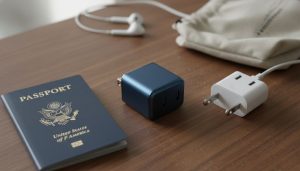
I also keep a small pouch for my cables and charger — because nothing’s worse than untangling wires at airport security.
Why GaN Power Banks Are Worth It (Even If They Cost More)
I remember when GaN chargers first came out, I thought, “Why pay double?” Then I tried one.
They’re compact, cool to the touch, and deliver consistent power even under load. If you’ve ever used a 100W GaN charger, you know it’s like going from a flip phone to a smartphone.
Real Benefits of GaN Chargers in Daily Use
- Smaller form factor fits in tight outlets.
- Less heat is safer for long sessions.
- Better efficiency wastes less power.
- Future-proof, compatible with next-gen devices.
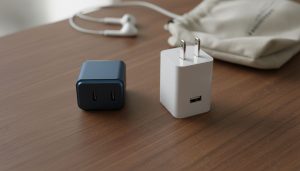
Power Bank Compatibility: More Important Than You Think
You can have the best charger in the world, but if your cable can’t handle the current, it’s like using a garden hose to fill a swimming pool.
Always check for certified cables that support your charger’s output. For example,
- A USB-C to USB-C cable that supports 100W will work better with PD chargers.
- A USB-A to USB-C cable usually maxes out around 18W.
Also, don’t overlook cable length; longer cables can cause a voltage drop. I usually stick to 1-meter cables for consistent performance.
Common Power Bank Mistakes and How to Avoid Them
Let’s be honest, we’ve all done these:
- Using old, frayed cables.
- Covering the charger with clothes while charging (it overheats).
- Leaving the charger plugged in 24/7.
- Using a 10W adapter on a 45W laptop.
I used to charge my phone overnight every day until I noticed battery degradation. Now I unplug it once it hits 90%. Small habits make a big difference.
Should You Use One Charger for Everything?
You can, but it’s tricky.
If your devices support USB-C PD and similar voltages, one 65W GaN charger can handle everything from phones to laptops.
But older gadgets (like cameras or Bluetooth speakers) might still need their original cables.
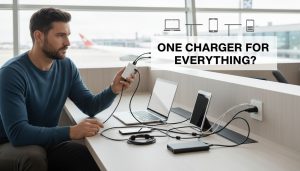
I keep one universal fast charger at home and one compact dual-port GaN in my travel kit. Simple, efficient, no guesswork.
FAQs: The Questions I Get Most Often
Q1. Can I use my laptop charger for my power bank?
Yes, if both support USB-C PD. Most laptop chargers are 60W–100W, so they’ll safely charge higher-end power banks. Just make sure the voltage matches the label.
Q2. Is it okay to leave my charger plugged in?
If it’s from a reputable brand with over-voltage protection, yes. But unplugging saves energy and keeps it cooler long-term.
Q3. Can a solar panel charge my power bank?
Yes, if it supports USB-C PD or QC output (18W+). I use one for camping, and it works well in strong sunlight.
Q4. How do I know my charger is losing performance?
If charging takes longer or the charger gets unusually hot, it may be time to replace it.
My Personal Setup for Travel Use
Here’s my current setup (and what’s worked best for me):
- At home: 100W GaN 3-port charger (charges laptop, phone, smartwatch).
- On the go: 30W compact GaN charger (fits anywhere).
- In the car: 45W PD car charger with dual ports.
- Backup: A 20,000mAh power bank that recharges with PD input.
For power banks, I highly recommend checking the models compared in Sheeel’s guide to the best power banks in Kuwait. They’ve tested reliable brands like Anker, Xiaomi, and RAVPower — and it’s a great reference point for choosing one that fits your needs.
Final Thoughts: Smart, Simple, and Safe Charging
Choosing the right power bank charger doesn’t have to be confusing. It’s just about knowing what matters:
- Match the wattage to your devices.
- Choose certified, reliable brands.
- Don’t chase unnecessary “extra-fast” speeds.
- Keep things cool, safe, and portable.
If you invest in one high-quality charger, you’ll save yourself frustration and maybe even a few melted cables.
Quick Recap of What You’ve Learned
✅ Understand your device’s power needs.
✅ Pick the right fast-charging protocol.
✅ Check safety and certification.
✅ Use proper cables.
✅ Consider travel-friendly options.
✅ GaN chargers = worth it.
So next time someone says “just get any charger,” you’ll know better and your devices will thank you for it.